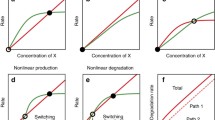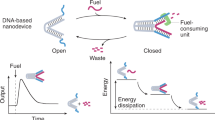Abstract
In this article, we introduce a new design for DNA logic gates based on enzymatic restriction of DNA strands. We present a construction for a set of one and two-input logic gates and argue that our construction can be generalized to implement any Boolean operation. A key feature of our design is its time-responsiveness, in the presence of appropriate fuels our circuit can operate continuously and generate a time-dependent output in response to a time-dependent input. Moreover, modulo connectivity information, the strand design and circuit design phases are decoupled.



Similar content being viewed by others
Notes
Laplace transform is a one-to-one mapping when defined on a set of well-behaved functions.
References
Adleman L (1994) Molecular computation of solutions to combinatorial problems. Science 266:1021–1024
Bayer TS, Smolke CD (2005) Programmable ligand-controlled riboregulators of eukaryotic gene expression. Nat Biotechnol 23:337–343
Benenson Y, Gil B, Ben-Dor U, Adar R, Shapiro E (2004) An autonomous molecular computer for logical control of gene expression. Nature 429(6990):423–429
Chen H, Anindya D, Goel A (2008) Towards programmable molecular machines. In: Proceedings of the 5th conference on foundation of nanoscience, Snowbird, Utah, pp 137–139
Isaacs FJ, Dwyer DJ, Ding C, Pervouchine DD, Cantor CR, Collins JJ (2004) Engineered riboregulators enable post-transcriptional control of gene expression. Nat Biotechnol 22:841–847
Macdonald J, Li Y, Sutovic M, Lederman H, Pendri K, Lu W, Andrews BL, Stefanovic D, Stojanovic MN (2006) Medium scale integration of molecular logic gates in an automaton. Nano Lett 6(11):2598–2603
Qian L, Winfree E (2008) A simple DNA gate motif for synthesizing large-scale circuits. In: Proceedings of the 14th international meeting on DNA based computers. Springer, Prague, Czech Republic
Reif JH, LaBean TH (2009) DNA nanotechnology and its biological applications. In: Bio-inspired and nanoscale integrated computing, Wiley, Hoboken, NJ, pp 349–375
Rothemund P (1996) A DNA and restriction enzyme implementation of turing machines. In: DNA based computers: proceedings of a DIMACS workshop, April 4, 1995, Princeton University, American Mathematical Society
Seelig G, Soloveichik D, Zhang DY, Winfree E (2006) Enzyme-free nucleic acid logic circuits. Science 314(5805):1585
Sherman WB, Seeman NC (2004) A precisely controlled DNA bipedal walking device. Nano Lett 4:1203–1207
Shin J-S, Pierce NA (2004) A synthetic DNA walker for molecular transport. J Am Chem Soc 126:10834–10835
Soloveichik D, Cook M, Winfree E, Bruck J (2008) Computation with finite stochastic chemical reaction networks. Nat Comput 7(4):615–633
Stojanovic MN, Mitchell TE, Stefanovic D (2002) Deoxyribozyme-based logic gates. J Am Chem Soc 124(14):3555–3561
Win MN, Smolke CD (2007) From the cover: a modular and extensible RNA-based gene-regulatory platform for engineering cellular function. Proc Natl Acad Sci USA 104(36):14283–14288
Win MN, Smolke CD (2008) Higher-order cellular information processing with synthetic RNA devices. Science 322(5900):456–460
Yin P, Turberfield AJ, Sahu S, Reif JH (2004a) Design of an autonomous DNA nanomechanical device capable of universal computation and universal translational motion. In: Proceedings of the 10th international meeting on DNA computing, Springer, Berlin, pp 344–356
Yin P, Yan H, Daniell XG, Turberfield AJ, Reif JH (2004b) A unidirectional DNA walker moving autonomously along a linear track. Angew Chem Int Ed 43:4906–4911
Yin P, Sahu S, Turberfield AJ, Reif JH (2006) Design of autonomous DNA cellular automata. Lect Notes Comput Sci 3892:399–416
Yurke B, Turberfield A, Mills A Jr, Simmel F, Neumann J (2000) A DNA-fuelled molecular machine made of DNA. Nature 406:605–608
Acknowledgment
The authors would like to acknowledge the anonymous reviewer of this paper whose comments were instrumental in improving the presentation of our work.
Author information
Authors and Affiliations
Corresponding author
Rights and permissions
About this article
Cite this article
Goel, A., Ibrahimi, M. A renewable, modular, and time-responsive DNA circuit. Nat Comput 10, 467–485 (2011). https://doi.org/10.1007/s11047-010-9237-6
Published:
Issue Date:
DOI: https://doi.org/10.1007/s11047-010-9237-6




